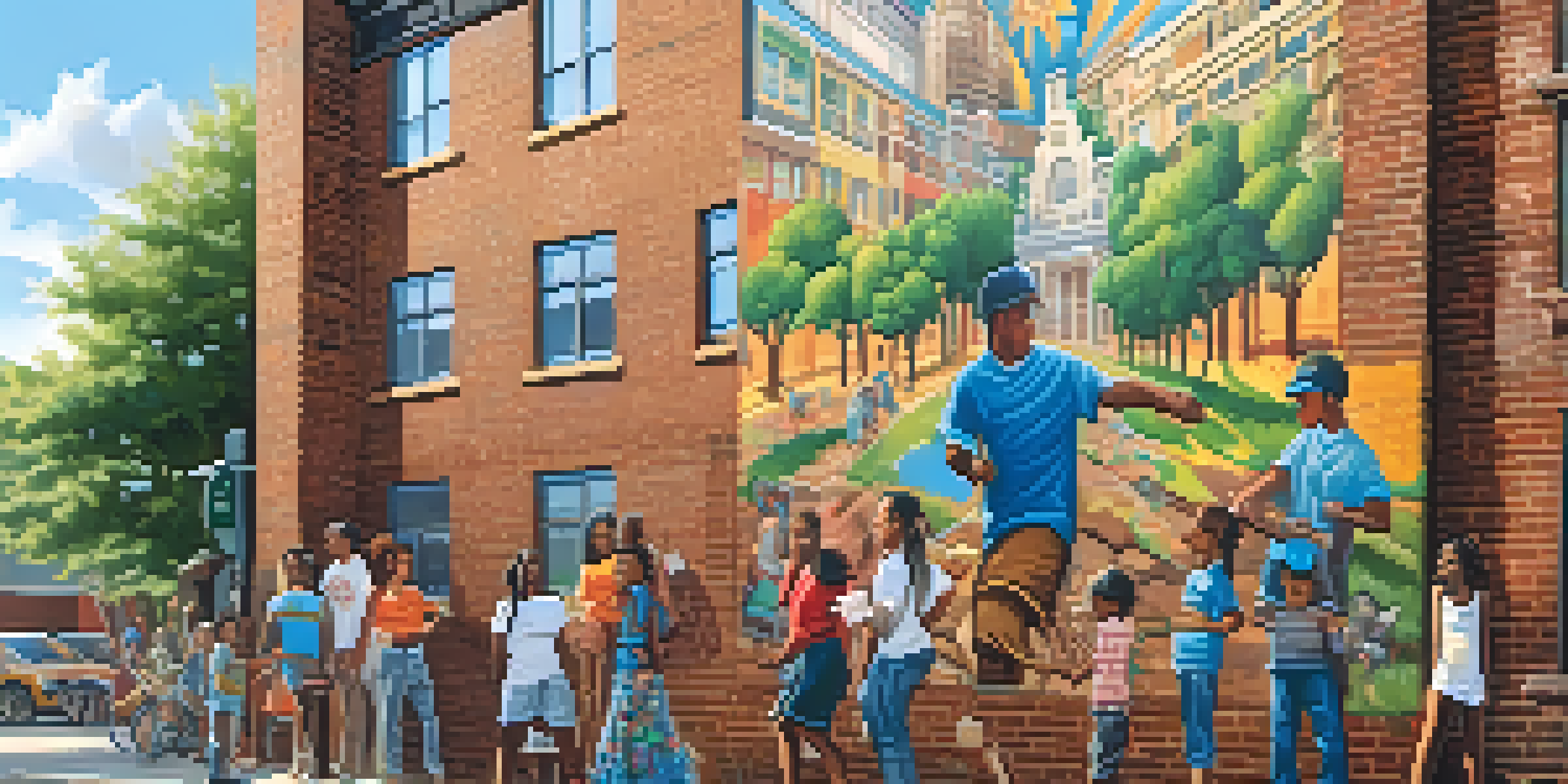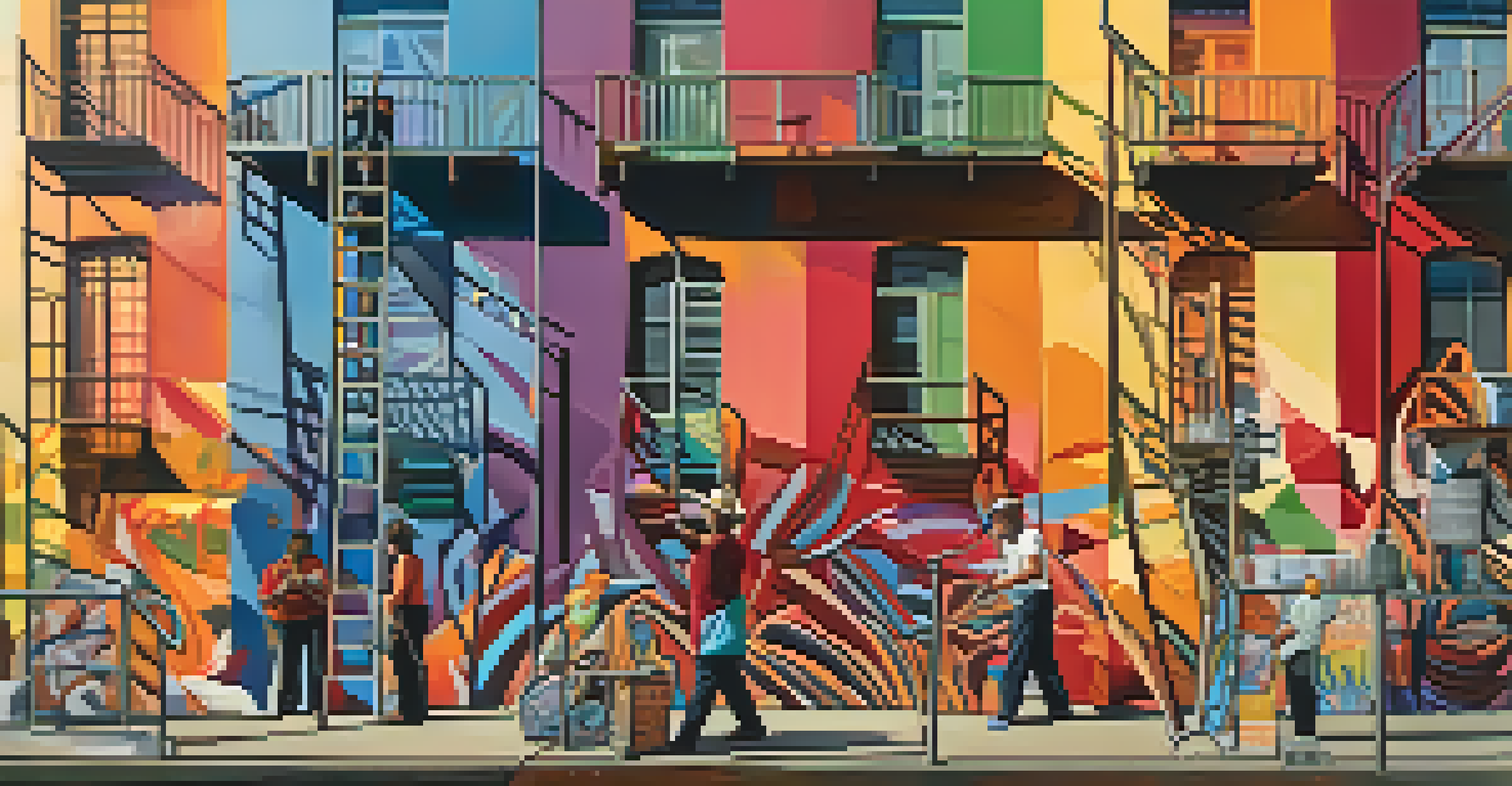Art in the Streets: The Rise of Urban Murals Worldwide

The Evolution of Street Art: From Graffiti to Murals
Street art has come a long way from its roots in graffiti. Initially seen as vandalism, this art form has evolved into a respected medium that beautifies urban spaces. Today, murals are celebrated for their creativity and ability to transform dull walls into canvases of expression.
Art is not a mirror held up to reality, but a hammer with which to shape it.
Artists like Banksy and Shepard Fairey have played pivotal roles in bringing street art to the forefront of contemporary culture. Their works often carry powerful messages that resonate with social issues, making them more than just decorative pieces. This shift has helped redefine public perception, turning once-stigmatized art into a celebrated form of communication.
Moreover, cities around the world have embraced murals as a way to enhance community identity and tourism. Local governments often commission artists to create large-scale works, turning neighborhoods into vibrant art districts that draw visitors and promote local culture.
Cultural Significance: Murals as Social Commentary
Murals serve as a powerful medium for social commentary, allowing artists to voice opinions on pressing issues. Whether addressing climate change, racial inequality, or political corruption, these artworks provoke thought and inspire dialogue within communities. They act as visual narratives that reflect the struggles and triumphs of society.

For example, the murals in Detroit depict the city’s rich history and cultural diversity while also addressing its economic challenges. This blend of artistry and activism not only beautifies the space but also fosters a sense of community pride and awareness. Such works remind us that art can be a catalyst for change.
Murals Enhance Urban Identity
Murals transform cityscapes, fostering community pride and identity through vibrant art that reflects local culture.
In this way, urban murals act as a mirror to society, capturing the zeitgeist of the times. They invite viewers to engage with their surroundings and reflect on the issues that matter most, creating a deeper connection between art and activism.
The Role of Technology in Urban Mural Creation
Technology has revolutionized the way murals are conceived and executed. Artists now use digital tools for planning, allowing them to visualize their work before a single brushstroke is made. This process not only streamlines the creation but also opens up new avenues for creativity and experimentation.
Every artist dips his brush in his own soul, and paints his own nature into his pictures.
Additionally, the rise of social media has enabled artists to showcase their work to a global audience. Platforms like Instagram and TikTok allow muralists to share their creative processes, engage with fans, and even attract commissions from cities worldwide. This visibility has elevated street art, positioning it as a significant player in the contemporary art landscape.
Moreover, some artists have begun incorporating augmented reality (AR) into their murals. This innovative approach adds an interactive layer, engaging viewers in a unique experience that blends the physical and digital worlds. Such advancements ensure that urban murals remain dynamic and relevant in our rapidly changing society.
Community Engagement: Murals as Collaborative Projects
Urban murals often involve the local community in their creation, fostering connections and collaboration. Community-based projects bring together artists and residents, allowing them to share their stories and ideas. This inclusivity helps create murals that truly reflect the values and identity of the area.
For instance, in many cities, mural festivals invite local artists and community members to collaborate on large-scale pieces. These events not only beautify the neighborhood but also strengthen community bonds, as everyone plays a role in the artistic process. The resulting artwork serves as a collective representation of the community’s spirit.
Technology Boosts Mural Creation
Digital tools and social media have revolutionized mural creation, allowing artists to visualize their work and reach global audiences.
Such collaborations also empower marginalized voices that might not otherwise be heard. By highlighting local stories and experiences, murals become a platform for dialogue and understanding, ultimately enriching the cultural fabric of urban areas.
Economic Impact: Urban Murals and Local Economies
Urban murals can significantly boost local economies by attracting tourists and increasing foot traffic. As people seek out vibrant art installations, businesses in the vicinity often see a rise in customers. This economic benefit is one reason many cities invest in public art initiatives.
Moreover, murals can enhance property values in neighborhoods, making them more appealing to potential buyers and investors. A well-placed mural can transform a forgotten area into a sought-after destination, leading to revitalization and economic growth. This phenomenon highlights the tangible benefits of supporting street art.
Communities that embrace urban murals often find that they contribute to a sense of place, making the area more inviting. This sense of identity can lead to increased community pride and investment in local businesses, creating a positive feedback loop that supports economic sustainability.
Global Perspectives: Murals Around the World
Urban murals can be found in cities across the globe, each reflecting unique cultural perspectives. From the colorful walls of La Boca in Buenos Aires to the politically charged murals of Belfast, these artworks offer a glimpse into the heart and soul of diverse communities. Each mural tells a story, shaped by local history and social dynamics.
In Mexico, vibrant murals often celebrate indigenous culture and history, while in Berlin, street art serves as a reminder of the city's divided past. These global variations highlight the adaptability of murals as a medium, capable of addressing local issues while resonating with universal themes.
Murals as Social Commentary
Urban murals serve as powerful platforms for social commentary, addressing pressing issues and inspiring dialogue within communities.
As cities continue to embrace this art form, we see the emergence of international mural festivals that connect artists from different backgrounds. These events foster cross-cultural exchange and collaboration, showcasing the power of urban murals to bridge gaps and unite people through creativity.
Challenges and Controversies in the Mural Movement
Despite their popularity, urban murals are not without challenges and controversies. Issues such as gentrification can arise when public art initiatives lead to the displacement of long-time residents. As neighborhoods become trendy, the very communities that inspired the art may find themselves pushed out, sparking debates about ownership and authenticity.
Additionally, the question of artistic freedom often comes into play. While many murals celebrate cultural expression, some can be polarizing or offensive to certain groups. This raises the issue of censorship and the balance between artistic expression and community standards.

Navigating these challenges requires ongoing dialogue among artists, community members, and local governments. By fostering an inclusive environment that respects diverse voices, the mural movement can continue to thrive and evolve, ensuring that art remains a tool for connection rather than division.